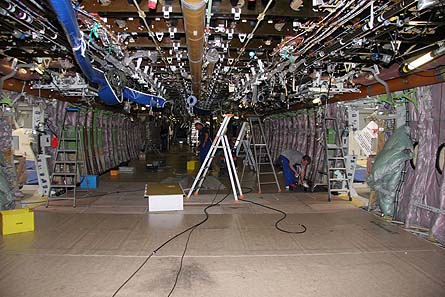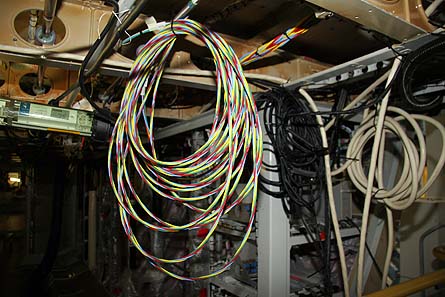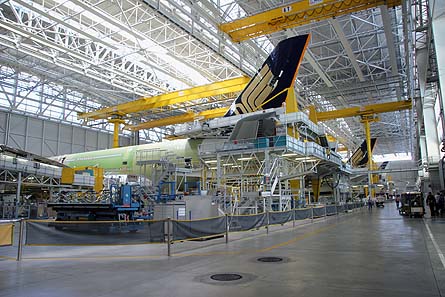By Max Kingsley-Jones in Toulouse
While executive heads have rolled, engineers at Toulouse are redoubling efforts to beat production problems
A little more than a month has passed since Airbus revealed to the world that it was battling with some fundamental production issues on its flagship A380 programme that would affect delivery schedules for at least the next two years.
|
|---|
| Teams of Airbus technicians are working through each deck to complete out-of-sequence work and the rewiring effort |
While that announcement has already resulted in the resignation of Airbus's chief executive, A380 production managers in Toulouse are well advanced in their efforts to get the programme back on track. Teams of technicians are poring over each aircraft in the assembly building to put right problems that have occurred essentially because Airbus was over-ambitious with its timetable for development and production of the world's largest airliner, and has been caught out by trying to undertake development and ramp-up production simultaneously.
While the delay is not expected to affect the first delivery to A380 launch operator Singapore Airlines (SIA) at the end of the year, it has resulted in significant hold-ups to deliveries of subsequent aircraft for SIA and other early operators, and will see a major reduction in the number of aircraft completed during the initial years of production.
The main cause of the delay lies with the need to replace or modify many of the hundreds of wiring harnesses that run through each aircraft, says vice-president A380 programme management Andreas Fehring. "We've had a much greater number of changes than expected resulting from modifications to electrical systems and structure following feedback from bench-testing, flight-testing and customisation needs," he says.
Fehring says that the problem has been exacerbated by the A380's scale and complexity, and the ambitious development timetable that had Airbus "undertaking customisation and production ramp-up in parallel". This has resulted in out-of-sequence work, which should have been completed during the subassembly build process, having to be performed on the final assembly line, he adds.
Fehring, a long-serving German Airbus cabin systems engineer, who was appointed to the Toulouse-based role on 1 April, was previously based in Hamburg as head of the A380's cabin/cargo customisation component management team. He says he now responsible for the "industrialisation of the A380", and as such is leading the team tasked with getting the programme out of the hole that it is now in.
Fehring is confident that, while a lot of work lies ahead, Airbus has got to the bottom of what originally caused the problem. "You slice up the elephant, then you eat the elephant - we know what we have to do now," he says.
Raft of rewiring
Airbus is reluctant to detail the specific changes to the A380's innards that have resulted in the raft of rewiring, or how much is the result of late changes by customers to cabin specifications versus modifications deemed necessary by the test programme. However, last week the manufacturer gave Flight International unrestricted access to one of the affected aircraft (MSN008, the fourth A380 for SIA) on the Toulouse asembly line, where Fehring provided a one-to-one briefing on the issues.
The latest wiring problems are not new, having first afflicted the development flight-test aircraft last year and delaying their first flights by months as they underwent modification. "The test aircraft were affected by late changes in specification during industrial ramp-up and had to undergo modifications at Station 30 - we had been caught out by this," says Fehring.
"We implemented the necessary changes to execute the flight-test programme, and addressed the upstream problems. That was the paperwork, we now have to physically address the issues on each of the customer aircraft," he adds.
Fehring says that Station 30 is the point in the build process on the final assembly line where each aircraft undergoes an electrical systems check ahead of power-on. "At this point normally, there should just be some finishing work, but the aircraft currently here are undergoing major rewiring," he says. Once A380 production has stabilised at the four units a month two years from now, Fehring says aircraft will spend around two weeks at Station 30, rather than the several months now being experienced.
"We had applied lessons learned from the problems encountered with the A340-500/600, but the A380 is an all-new aircraft incorporating a huge amount of new technology," says Fehring.
Although Airbus had built a contingency plan into the A380's ambitious development schedule, it was caught out by the high volume of changes required, says Fehring. "You can plan for a certain amount of unexpected issues, but we have simply eaten up our contingency," he says.
The wiring problems boil down to two simple fundamentals: a harness may need to be extended or replaced because it is too short following a configuration change, or may require modification due to a specification change.
"Changes have been coming back from flight testing or bench testing of systems," says Fehring. "For example, we may need to improve the functionality of a system and update the wiring bundle, or relocate a fixed item inside the aircraft or reroute wiring, which affects the length of cabling required."
Fehring says that in the design phase Airbus tried to forecast harness routeings around rigid components to determine required lengths and configurations as accurately as possible using tools such as the digital mock-up, "but some things cannot be verified until you fly the aircraft".
Cable routeing
|
|---|
| Airbus technicians are installing full replacement harnesses where necessary, but wiring kits have also been developed |
For example, it may be that during flight testing it is established that a "pure power cable and an electrical signal line are running too close to each other, so they would have to be separated to avoid electrical interference", says Fehring. "A change to a bracket location, which alters a cable routeing, could require a longer harness, or if the cable has to be rerouted around a fixed, rigid item, such as water waste pipe," he adds.
Fehring says Airbus has developed two basic fixes where harnesses are found to be unsuitable. "For simple definition changes we can modify with a kit - that is a bundle that could contain say, 13 wires. If there are routeing changes and the existing cable is too short we will need to replace the entire harness," he says.
He adds that replacement of the complete harness, rather than simply crimping in an extension, is necessary as "we have to be wary of increasing electrical resistance in the wires, and every time we add a new connection it would affect this". The complexity of the cables cannot be underestimated, says Fehring as "they are just not running from A to B, they're going from A to B to C to D to E, etc".
He says a change that needs to be verified in flight testing "will have to be installed on the three flight-test aircraft as well as the other 10 structurally assembled airframes, so even a relatively straightforward revision that requires 100h per aircraft adds up to 1,300h of work".
Like any other aircraft, the A380's wiring harnesses run throughout the fuselage, but the ultra-large-aircraft's full double widebody passenger deck configuration makes the layout much more complex. For example, the main deck ceiling forms the floor of the upper deck, so it carries a mass of cables that serve both overhead needs of the main deck as well as some of the requirements for the upper deck.
"We have around 500km [310 miles] of cabling, compared with 300km on an A340," says Fehring.
Other aspects of the new aircraft design mean that its electrical requirements far exceed previous aircraft, says Fehring. For example, the A380 is the first airliner to incorporate a complex electronic "central nervous system" - dubbed the network server system - and is also the first to feature electrically operated passenger doors and has a sophisticated cabin lighting system offering mood control.
Customers have also specified an unprecedented standard of in-flight entertainment, says Fehring. "Every seat in the aircraft has its own independent monitor, and there are typically around 500 of them in each aircraft."
Airbus production engineers have had to climb a steep learning curve, made worse by the attempt to develop the aircraft and define customer airframes simultaneously. "We're trying to determine the right split between standardisation and customisation," says Fehring. "We are still building our database to establish what should be a standard item on each aircraft, and what needs to specific to a customer."
Fehring is understandably reluctant to blame customers for last-minute revisions to their cabin specifications, although it is clear that late changes have been a factor. "We gave customers a very early definition freeze for their cabin specifications to ensure that the manufacturing process was fully running downstream. However, because of the early cut-off, some of the cabin features specified had not been fully thought through by the customers," he says. "This resulted in some late specification changes, which we agreed with the customers to implement through our established change process."
This involves an investigation to determine what the impact will be on the industrial process and therefore whether the change is feasible. "If it is not feasible to introduce the change on the first aircraft then we tell the customer that it has to be introduced on a later aircraft," says Fehring. He adds that although Airbus is "still agreeable to late changes", as a result of the recent experiences it has "increased the amount of investigation carried out into the impact on the production process, as well as the exchange with the customer on what that impact will be".
Out of sequence
The progress of aircraft on the final assembly line has been slowed by the need for out-of-sequence work to be undertaken by working parties despatched from the main subassembly production plants at St Nazaire (where the nose and centre fuselage is produced) and Hamburg Finkenwerder (where the rear and forward fuselage is built), as well as from the wing assembly line at Broughton in the UK. "They are carrying out work that should have been done during the subassembly process," says Fehring.
He says the build-up in outstanding work resulted from the policy last year to ship subassemblies to Toulouse incomplete, rather than hold them back and cause a bottleneck. "As each milestone in the build process was reached, if the required work had not been finished then the assemblies were delivered to the final assembly line uncompleted to avoid slowing the production rate," he says.
|
|---|
| SIA aircraft account for the bulk of the A380s undergoing modifications in the final assembly line building |
Production ramp-up had begun in August last year when final assembly was restarted after a brief suspension following the construction of the initial batch of A380s. "Last year we tried to increase the level of completion of subassemblies arriving at the final assembly line based on our requirements arising from the original delay, but the level of completion achieved was not what we had anticipated," says Fehring.
The changes could not be implemented as planned because Airbus was overwhelmed, says Fehring. "The quantity of changes was higher and the types of changes were different to what had been anticipated."
But after publicly disclosing the severity of the problems last month, there is now some light at the end of the tunnel for Airbus. The first customer A380 (MSN003) was ferried to Hamburg in May for cabin installation and is to be completed in time for year-end delivery to SIA. Although Fehring is vague about the delivery schedule beyond MSN003, he is confident SIA's second aircraft, MSN005, will soon fly and be ready to depart for Hamburg "in the coming weeks".
Fehring declines to say when the second SIA aircraft will be ready for delivery, but hints it will not be too far behind the first, pointing out that an airline needs "a minimum of two" when introducing a new aircraft model into service.
Source: Flight International






















